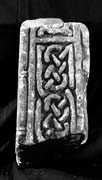Select a site alphabetically from the choices shown in the box below. Alternatively, browse sculptural examples using the Forward/Back buttons.
Chapters for this volume, along with copies of original in-text images, are available here.
Object type: Part of cross-shaft [1]
Measurements: H. 35 cm (13.8 in); W. 16 > 15.5 cm (6.3 > 6.1 in); D. 16.5 > 16 cm (6.5 > 6.3 in)
Stone type: Sandstone, yellow-buff, soiled, medium grained, slightly micaceous (similar to Leeds (St Peter) 2a). Carboniferous — Pennine Coal Measures Group? [G.L.]
Plate numbers in printed volume: Ills. 505-8
Corpus volume reference: Vol 8 p. 203-4
(There may be more views or larger images available for this item. Click on the thumbnail image to view.)
Part of a small cross-shaft, almost square in section. The rounded edge mouldings are very battered, but on faces A and C show clearly that they were carved to represent a series of baluster shafts or columns with rounded capitals and bases. The carving is not deep but the background surface is dressed smooth and the carving is delicately modelled and confidently handled. All faces have vertical inner roll mouldings, but only face A shows evidence for a panelled style of organisation.
A (broad): Divided by inner roll mouldings into two narrow panels. (i) Most of the upper panel is missing. There is only a rounded lower terminal, perhaps of a plant-scroll as there appears to be a small pointed leaf in each lower corner. (ii) The lower panel has a fine-stranded interlace, showing two registers of simple pattern F with outside strands.
B (narrow): Within the roll mouldings the remaining face has a fine-stranded double twist.
C (broad): Two volutes of a simple plant-scroll, each terminating in a tri-lobed flower. There are no bindings on the slender stem. A round bud fills the surviving spandrel; and the upper volute has a complex drop leaf — a long pointed leaf between a round bud and a smaller pointed leaf.
D (narrow): An even finer version of the scroll on face C, with three volutes each ending in a tri-lobed flower. The lowest spandrel produces the same round bud as on C, and the drop leaf from the upper volute is almost identical to that on C. The drop leaf from the central volute produces one curved frond-like leaf and another long leaf of less determinate form.
The use of plant-scroll on two, perhaps three, faces; the indications of a panelled layout on face A; the overall layout and the square section, all suggest that this is an early piece. The twist on face D is paralleled, though in a more rounded style, at Jarrow 22, co. Durham, which has been dated late seventh to early eighth century (Cramp 1984, 115–17, pls. 99.527–8, 100.529–34). A somewhat later example is on Urswick 1, Lancashire (Bailey and Cramp 1988, 148–50, ill. 566), dated to the ninth century, while at North Otterington, in northern Yorkshire, a stone with the same twist is dated late ninth to tenth century (Lang 2001, 186, no. 3, ills. 694–7). The pattern is also found at Frickley in the West Riding, on stones which are clearly attempting to follow earlier Anglian patterns in plant-scroll as well as in interlace (see Frickley 2 and 3, Ills. 265, 267, 273). The pattern is unusual but clearly relates to early Anglian traditions.



